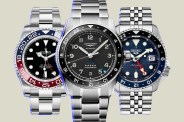Your simple sport watch might not be fulfilling all its potential. If it’s merely been telling you the time but also features a rotating bezel — that ring around the crystal that often has markers or scales on it — there’s a good chance it can work harder for you. Not all bezels turn or feature scales, but on many sport watches they rotate in one direction or both — if you don’t already know whether or not your watch has this kind of turning bezel, now’s the time to go ahead and find out. We’ll wait.
How to use a watch with a 12-hour bezel
The type of watch made especially for displaying a second time zone is called a GMT, and it uses an additional hand on the dial that shows the hour in 24-hour format. Depending on the age of the watch and the design, this is usually accomplished with the aid of a rotating bezel with 24 hours markers.

However, if you have a watch with a rotating bezel and 12 hour markers, congratulations: you can use it to track the time in a second time zone without the need for a GMT movement: Just align the bezel’s hour markers to correspond to the time difference that’s relevant to you, and presto: you can read the local time by where the hands are pointing on the dial, and the “away” time according to where the hands are pointing on the bezel (or vice versa, if you choose).
For example: NYC is 5 hours behind London. If you travel to London and want to know what time it is back home, you would rotate the bezel 5 clicks to the right until “7” appeared above the watch’s 12 o’clock hour marker. Now, the hours in NYC correspond to the hours in local London time. (You simply have to account for AM and PM.) Also, like GMTs, this can be useful for more than traveling, as we all live in an ever more interconnected world with friends and colleagues in other time zones.
